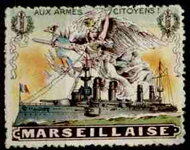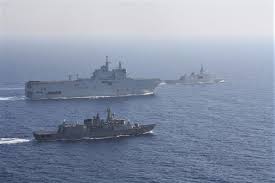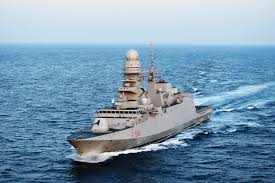Stamp: Marseillaise. Aux Armes Citoyens (Cinderellas 1914)
Marseillaise. Aux Armes Citoyens (Cinderellas 1914)
01 January (Cinderellas ) within release France : First World War Delandre Vignettes goes into circulation Stamp Marseillaise. Aux Armes Citoyens face value None No Face Value
| Stamp Marseillaise. Aux Armes Citoyens in catalogues | |
|---|---|
| Colnect codes: | Col: FR-DEL 1914-70 |
Stamp is square format.
French Marine SeriesAlso in the issue France : First World War Delandre Vignettes:
- Stamp - 130° Rt Territorial. Infantry Regiment face value None;
- Stamp - 16eme de Train. Mounted Regiment face value None;
- Stamp - 347 Infantry Regiment face value None;
- Stamp - 44 Territorial. Infantry Regiment face value None;
- Stamp - 50° Rt de Ligne. Infantry Regiment face value None;
- Stamp - 73° Rt de Ligne. Infantry Regiment face value None;
- Stamp - 94° Rt de Ligne. Infantry Regiment face value None;
- Stamp - 219 de ligne Infantry Regiment face value None;
- Stamp - Pro Patria face value None;
- Stamp - Punch and Judy. Exposition 1914 Lyon face value None;
- Stamp - 12th Territorial Infantry Regiment face value None;
- Stamp - 12th Territorial Infantry Regiment face value None;
- Stamp - 1ère Escadrille De Sous Marins De La Première Armée Navale face value None;
- Stamp - 1st Chasseurs face value None;
- Stamp - 1st Tonkin Riflemen Regiment face value None;
- Stamp - 2e Escadrille De Sous Marins De La Première Armée Navale face value None;
- Stamp - 2e Régiment De Fusiliers Marins face value None;
- Stamp - 4th Engineers Regiment face value None;
- Stamp - 64th Infantry Regiment face value None;
- Stamp - Amiral Charner face value None;
- Stamp - Aventurier face value None;
- Stamp - Bearn face value None;
- Stamp - Bretagne face value None;
- Stamp - Bruix face value None;
- Stamp - Cassini face value None;
- Stamp - Charlemagne face value None;
- Stamp - Compagnies de débarquement face value None;
- Stamp - Conde face value None;
- Stamp - Condorcet face value None;
- Stamp - Courbet face value None;
- Stamp - Cuirasse Lorraine face value None;
- Stamp - Danton face value None;
- Stamp - Democratie face value None;
- Stamp - Desaix face value None;
- Stamp - Diderot face value None;
- Stamp - Du Chayla Croisier de 2e Classe face value None;
- Stamp - Dunkerque Hydroaeroplanes face value None;
- Stamp - Dupleix face value None;
- Stamp - Ecole des Fusiliers marins face value None;
- Stamp - Edgar Quinet face value None;
- Stamp - Ernest Renan face value None;
- Stamp - Escadrilles de sous marins de Cherbourg et de la Manche face value None;
- Stamp - French Red Cross face value 2;
- Stamp - French Red Cross face value 5;
- Stamp - French Red Cross. Assoc French Ladies. Langres Commitee face value None;
- Stamp - French! Made in Germany. Do not buy face value None;
- Stamp - French! Remember Do not buy german goods face value None;
- Stamp - Gloire face value None;
- Stamp - Henri IV face value None;
- Stamp - HMS Centurion face value None;
- Stamp - HMS Colossus face value None;
- Stamp - HMS Dominion face value None;
- Stamp - HMS Gloucester face value None;
- Stamp - HMS King Alfred face value None;
- Stamp - HMS Neptune face value None;
- Stamp - HMS Nubian face value None;
- Stamp - HMS Queen Mary face value None;
- Stamp - Honour Country Central Material Aerostation face value None;
- Stamp - Honour Country Central Material Aerostation. Overprint face value None;
- Stamp - Jauré Guiberry face value None;
- Stamp - Join French Propaganda to help French Industry face value None;
- Stamp - Jules Michelet face value None;
- Stamp - Kleber face value None;
- Stamp - La Motte Piquet face value None;
- Stamp - Laboratory Bacteriology face value None;
- Stamp - Languedoc face value None;
- Stamp - Latouche Tréville face value None;
- Stamp - Le Duquesne face value None;
- Stamp - Le Mirabeau face value None;
- Stamp - League Protection Antii-Germanic Cote d'Azur Nice. Get Rid face value None;
- Stamp - Leon Gambetta. There is only one France face value None;
- Stamp - Marine Blockade Signal of Distress face value None;
- Stamp - Marseillaise. Aux Armes Citoyens face value None;
- Stamp - Mortier face value None;
- Stamp - Noel. Que fait-il? Christmas. How is he? face value None;
- Stamp - Notre 75 Artillery Regiment face value None;
- Stamp - Paris face value None;
- Stamp - Patrie face value None;
- Stamp - Pothual face value None;
- Stamp - Pro Patria Without Fail Unto Victory face value None;
- Stamp - Remember Scarborough face value None;
- Stamp - Republique face value None;
- Stamp - Saint Louis face value None;
- Stamp - Superdreadnought Lyon face value None;
- Stamp - Superdreadnought Marseille face value None;
- Stamp - Superdreadnought Tourville face value None;
- Stamp - Take up the sword of Justice. Remember face value None;
- Stamp - Torpilleurs Escadre face value None;
- Stamp - Voltaire Honneur Patrie face value None;
- Stamp - Waldeck Rousseau Croiseur Cuirassé face value None;
|
Data entry completed
50%
|
|
|---|---|
| Stamp Marseillaise. Aux Armes Citoyens in digits | |
| Country: | Cinderellas |
| Date: | 1914-01-01 |
| Emission: | Cinderella |
| Format: | Stamp |
| Face Value: | None No Face Value |
Stamp Marseillaise. Aux Armes Citoyens it reflects the thematic directions:
In Abrahamic religious traditions (such as Judaism, Christianity, and Islam) and some sects of other belief-systems like Hinduism and Buddhism, an angel is a heavenly supernatural or spiritual being. In monotheistic belief-systems, such beings are under service of the supreme deity (i.e. God).
Abrahamic religions often depict angels as benevolent celestial intermediaries between God and humanity. Other roles include protectors and guides for humans, such as guardian angels and servants of God.[3] Abrahamic religions describe angelic hierarchies, which vary by religion and sect. Some angels have specific names (such as Gabriel or Michael) or titles (such as seraph or archangel). Malevolent angels are often believed to have been expelled from Heaven and called fallen angels. In many such religions, the Devil (or devils) are identified with such angels
World War I or the First World War (28 July 1914 – 11 November 1918), also known as the Great War, was a global conflict between two coalitions: the Allies (or Entente) and the Central Powers. Main areas of conflict included Europe and the Middle East, as well as parts of Africa and the Asia-Pacific. There were important developments in weaponry including tanks, aircraft, artillery, machine guns, and chemical weapons. One of the deadliest conflicts in history, it resulted in an estimated 30 million military casualties, plus another 8 million civilian deaths from war-related causes and genocide. The movement of large numbers of people was a major factor in the deadly Spanish flu pandemic.
A navy, naval force, military maritime fleet, war navy, or maritime force is the branch of a nation's armed forces principally designated for naval and amphibious warfare; namely, lake-borne, riverine, littoral, or ocean-borne combat operations and related functions. It includes anything conducted by surface ships, amphibious ships, submarines, and seaborne aviation, as well as ancillary support, communications, training, and other fields.
A ship is a large watercraft that travels the world's oceans and other sufficiently deep waterways, carrying passengers or goods, or in support of specialized missions, such as defense, research and fishing. Historically, a "ship" was a sailing vessel with at least three square-rigged masts and a full bowsprit. Ships are generally distinguished from boats, based on size, shape and load capacity.
A warship or combatant ship is a ship that is used for naval warfare. Usually they belong to the navy branch of the armed forces of a nation, though they have also been operated by individuals, cooperatives and corporations. As well as being armed, warships are designed to withstand damage and are typically faster and more maneuverable than merchant ships. Unlike a merchant ship, which carries cargo, a warship typically carries only weapons, ammunition and supplies for its crew.




